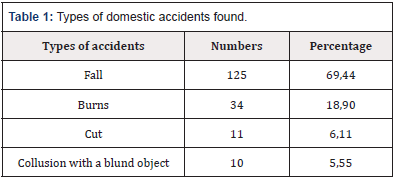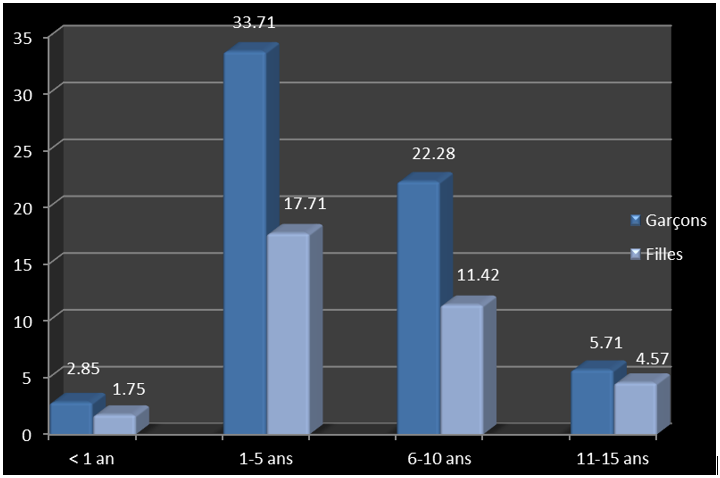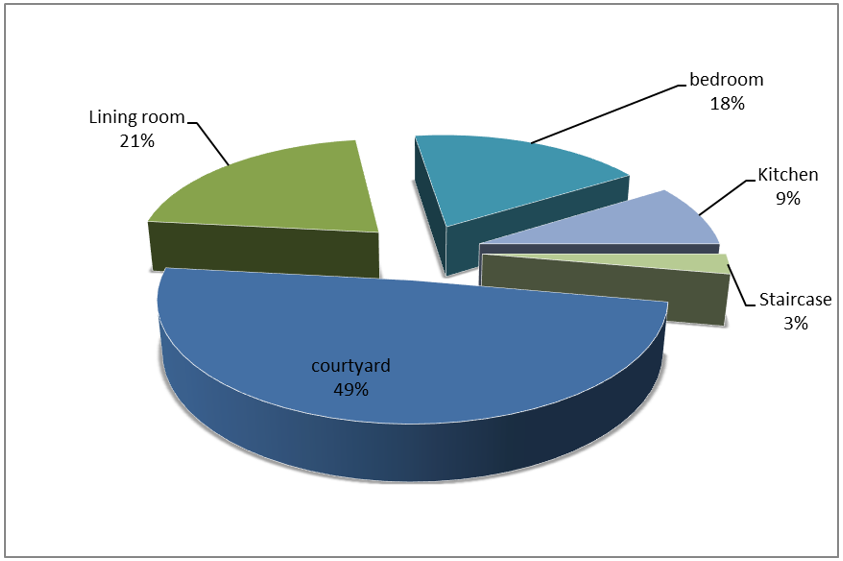Review Article 
 Creative Commons, CC-BY
Creative Commons, CC-BY
Epidemiological Profiles and Prognoses of Pediatric Domestic Trauma in the Emergency Department of the OWENDO University Hospital Center. Gabon
*Corresponding author: Matsanga Arthur, Department of Anesthesia-Resuscitation and Emergencies, Owendo University Hospital, Gabon.
Received: February 14, 2022; Published: March 15, 2022
DOI: 10.34297/AJBSR.2022.15.002157
Abstract
Objective: The aim of this work was to establish the epidemiological and prognostic profile of traumatic accidents occurring at home treated in the emergency department of the Owendo University Hospital Center in Gabon from January 1, 2019, to June 30, 2020.
Patients and Method: This is a prospective and descriptive study over a period of six months. Children victims of unintentional trauma occurring at home or in its immediate surroundings were included. We noted the age and sex of the child, the day, the time of occurrence of the accident, the presence or not of an adult at the time of the accident, the mechanism of the accident and the place of occurrence. We also studied the prognosis exclusively considered from the angle of death.
Results: 180 children were included. The average age was 6.3±2 years with a male predominance. Patients under 5 years old were the most affected (56.02%). In 63.75% of cases the accident occurred in the absence of an adult. The fall is the main accidental mechanism 69.44% (n=125). Traumatic lesions concerned the limbs in 60% of cases. Long bone fractures were the most common lesion 36.11%. More than half of traumatic domestic accidents occurred in the evening between 3 p.m. and 10 p.m. (62.32%). we recorded 3 cases of death including 2 for serious head trauma and one case for burns, i.e., a mortality of 1.6%.
Conclusion: Pediatric domestic trauma is little studied in African countries. They are responsible for significant morbidity and mortality.
Keywords: Trauma, Domestic, Pediatric, CHUO
Introduction
For the World Health Organization (WHO), an accident is defined as “an event which, in a generally short chronological sequence, leads to a transfer of energy between a source and a target structure likely to be modified, reversible or not”. Domestic accidents are defined as accidents that have been canceled at home or in its immediate surroundings [1]. Domestic accidents in children represent a real public health problem in industrialized countries [2]. In Africa, priority in public health is always given to infectious pathologies. In Gabon, the real extent of accidental traumatic domestic pathologies in children remains unknown due to the lack of national data. The objective of our study is to establish the epidemiological and prognostic profile of traumatic accidents occurring at home.
Population and Methods
Population
This is a cross-sectional prospective study with descriptive and analytical aims. It took place over a period of six months from January 1, 2019, to June 30, 2020. The emergency department of the OWENDO University Hospital Center (CHUO) served as the study setting. All child victims of unintentional domestic trauma occurring at home or in its immediate surroundings were included. We excluded other types of domestic accidents (accidental poisoning, drowning, etc.), child victims of road accidents and those treated for another pathology.
Study Methods
The study variables were age and sex, day, and time of occurrence of the accident, presence of an adult at the time of the accident, mechanism of the accident and place of occurred. We have also considered the prognosis exclusively considered from the angle of death. Statistical analysis was done with EPI info V.3.5.1 software.
Results
During this study period, 2102 patients were treated in the emergency department, including 515 children, i.e., 24.5%. The frequency of pediatric traumatic domestic accidents was 34.95% (n=180) children out of 515. The average age of patients was 6.3±2 years with extremes ranging from 1 month to 15 years. The male sex predominated in 60.4% (n=108) i.e., a sex ratio of 1M/1.5F. The most affected age group was that of 1 to 5 years (55.42%) with a clear male predominance (33.71%) (Figure 1), followed by that of 5 to 10 years 33.70%. Children under 1 year old represented 4.44% (n=8). broken families. None of the children in our series had a preexisting disability. Only 2% of children had already been the victim of a previous domestic accident. The fall was the main accidental mechanism 69.44% (n=125) regardless of age and type of accident, followed by burns 18.88% (Table 1). The etiologies were dominated by playful accident in 72.2% of cases.
According to the place of occurrence of the accidents, 49% (n= 88) of the injuries occur in the yard. Location followed by living room 21% (n=38), bedroom 18% (n=33), kitchen 8.90% (n=16) and stairs 3% (n=5) (Figure 2). Injuries occur in 78% of cases in children living in under-integrated neighborhoods. Traumatic lesions concerned in 60% of the cases the limbs with a predominance of the upper limbs (36%). Part of the body followed by the head 18% (n= 34) and the thorax 8% (n= 15). The other parts of the body were slightly affected (Figure 2). Long bone fractures were the most frequent lesion 36.11% (n=65) followed by wounds 30.55% (n=55), contusions (12.22%), burn injuries 11.11% (n=20), ankle sprains 5.55% (n=5), acute subdural hematomas 1.11% (n=2) and one case of spleen fracture.
Most traumatic domestic accidents occurred in the evening between 3 p.m. and 10 p.m. (62.32%). Time slot followed by the morning between 7 a.m. and 2 p.m. (36.66%) and only 1.66% of accidents occurred after 11 p.m. Injuries by domestic accidents occurred every day of the week with a peak on Wednesdays (30.2%) and Saturdays (33.72%). On the therapeutic level, 81.20% of patients sent home after treatment in the emergency department, 18.8% benefited from hospitalization in the orthopedic service 17% (n=31) for treatment specialist and 1% (n=2) in resuscitation for severe head trauma. On the prognostic level, we recorded 3 cases of death including 2 for serious head trauma and one case for burns, representing a mortality of 1.6% of traumatic domestic accidents. Death occurred on average 2.1 days after patient admission.
Discussion
Domestic accidents are poorly documented in developing countries, particularly in sub-Saharan Africa despite their high frequency and severity. In these countries, the concerns primarily concern infectious diseases and malnutrition [3]. In our study, the pediatric traumatic domestic accident represents 24.5% of all consultations and 12.6% of hospitalizations in the traumatological emergency unit of the University Hospital of Owendo. They are therefore one of the frequent accidents in pediatric traumatology. This observation is like that of AS Mohamed and Dakar [4] who found a frequency of 48.3% in his work on the epidemiology and prognosis of child accidents in DAKAR as well as by several series of literature [5-6].
Sex and Age
Our series finds a clear male predominance (64.55%). Predominance which is explained by the turbulent behavior of male children, more inclined to running and jumping games exposing them to domestic accidents. Male predominance is classically found in all studies of accidents in children. Kaboro, et al. [7] in Ndjamena, Klouche, et al. [8], respectively found a male predominance of 62.22% and 62.9%. In our study, the 0- to 5-year-old age group was the most affected with 51.42% of cases. This result agrees with those found by Gaudeuille [9] in Bangui and S. ATEGBO [10] who found respectively 36% and as well as many of the authors [11-12]. However, the results of the Epac carried out in 2004 found a slight predominance of children in the 11- to 16-year-old bracket [13].
Place and Time of Occurrence of The Accident
The most frequent place of occurrence in our series was the courtyard 49% (n=88), followed by the living room 21% (n=38). This observation has already been made by H.DJIBO in Niamey [14]. Zidouni in Algeria made a different observation with a predominance of accidents in the bedroom followed by the courtyard, the kitchen and then the stairs [15], joining French data [11,18].
The high frequency of pediatric domestic trauma among children in the yard in this work can be explained by the absence of play areas in most neighborhoods in Libreville and its surroundings, exposing these young people to play on rough terrain.
The fall is the main mechanism for the occurrence of domestic trauma in our series at a frequency of 69.44% (n=125) of cases. Burn follow-up 18.90% (n=34). Klouche [8], found that falls represented the most frequent accident followed by burns in respective proportions of 44.9% and 18.5%. Other authors also place falls as the main mechanism for the occurrence of traumatic domestic accidents [4,5&11]. This can be explained by the fact that running game and jumping games are the main activities of children at home.
More than half of the injuries (62.32%) in our work occur in the late afternoon and evening between 3 p.m. and 10 p.m. Results like those of other authors [5-8-13]. This time slot corresponds to the children leaving school, returning home they engage in the activities of the games. In our series, domestic accidents occur every day of the week with a peak on Wednesdays and Saturdays. S. Ategbo and A. Agbere [15] found a peak in domestic accidents on weekends. This observation has not been made by several authors. Kaboro et al found fewer accidents in their work (8.67% of cases) on Sunday, which is a non-working day. The same observation was made by Gaudeuille, et al. [9], and by KA, et al. [6], who recorded a lower number of accidents during the non-working day, respectively 7.3% and 6.6% of cases. For Reinberg, et al. [14] there is no significant variation in the number of accidents depending on the day of the week.
Seats and Types of Lesions
In this work, the traumatic lesions are mainly located in the upper limbs in 36% of cases, in the lower limbs in 24% of cases and 18% of cases in the head. For the Kaboro team in Chad, the lesions were preferentially located in the head and limbs respectively in 30% and 29.70% of cases. The similar observation had been made by Gaudeuille [9]. Fractures are the main in our series with 36.11% of cases, followed by wounds 30.55% of cases. A.S Mohamed found an identical result in Dakar where fractures and wounds represented respectively 54.9% and 14.2% of cases [4]. In Western studies, cuts and wounds come first [16,18]. The high percentage of fractures and frequently involving the upper limbs in our study can be explained by the fact that during falls, the child falls to the ground by putting his arm forward to protect his head.
Management and Prognosis
On the evolutionary level, 81.20% of patients discharged home after treatment in the emergency department, 18.8% benefited from surgical management. In our study, we note a death rate of 1.6% close to that found by Mabiala Babela, et al. 1.26% (4 deaths out of 317 cases) [19] and 1.2% in the Dakar study.
Conclusion
Pediatric domestic traumas are underestimated, and little studied in our context. They are responsible for significant morbidity and mortality. These accidents most often occur at a time when parental vigilance is low.
Conflict of Interest
The authors declare no conflict of interest.
Authors’ Contribution
All authors contributed to the design and implementation of this study. All authors have read and approved the final version of the manuscript.
References
- Baudet M, Amouroux N, Houin G (2004) Accidental domestic poisoning. EMC-Toxicology Pathology 1(2): 29-34
- Alix D, Furet E, Blouet JH, et al. (1998) Domestic accidents in children: evaluation, prevention and inter-institutional collaboration. Ann Pediatr 45(1): 48-53.
- (2001) World Health Report 2000. WHO pp. 182.
- AS Mohamed, A Omid, AL Faye Fall, PA Mbaye (2015) Domestic accidents in children in Dakar: about 555 cases. Journal of Pediatrics and Child Care.
- Phelan KJ, Khoury J, Kalkwarf H, Lanphear B (2005) Residential injuries in US children and adolescents. Public Health Rep 120: 63-70.
- Zidouni N (2000) Child domestic accidents in rural areas. Results of the survey carried out in 2000 by the INPS.
- Kaboro M, Silé SN, Djonga O, Djada D, Dionadjii M (2012) Accidental trauma in children admitted to the emergency department of the N'Djamena General Reference Hospital (Chad).
- Klouche, Atek, Larbi A (2001) Accidents in children in Algiers. Rev. Health Maghreb 64: 617-671.
- Gaudeuille A, Bobossi Serengbe G, Kolouba JM, Mandaba JL (2002) Epidemiology of accidents in children in Bangui (Central Africa). Review Med Afr Black 49: 557-560.
- Ategbo S, Minto'o S, Koko J, Mengue Mba Meyo S (2012) Epidemiological aspects of domestic accidents in children in Libreville (Gabon). Clin Mother Child Health 9: 1-3.
- Thélot B (2010) Epidemiology of everyday life accidents in children. Arch Pediatr 17: 704-705.
- Molinié E, Cicurel JP (2008) Child safety, what do we do? The white paper on everyday life accidents, 15. National Consumer Institute pp. 5-29.
- Thélot B (2003) Health Watch Institute, Chronic Diseases and Trauma Department 2003. EPAC network.
- Hamadou Djibo, S Badio, S Guidah, I Kamaye (2011) Domestic accidents in children under 5 cases. J Afr Imag Med 4(7): 363-367.
- Zidouni (2000) Domestic accidents in children in rural areas. Results of the survey carried out in 2000 in Tunis by the INPS.
- Reboli E (2006) Accidents in everyday life: descriptive study based on the collection of 10,177 data, EPAC 2004 from the pediatric emergency department of Le Havre and prevention projects for the Le Havre conurbation. Rouen: Joint Faculty of Medicine and Pharmacy of Rouen.
- Agbere, E Kpemissi, DY Atakouma, N Kuakuvi, K. Kessie, et al. (1994) Domestic accidents and envenomations in children at the Kara regional hospital (Togo) (French), Med Afr Noire 41: 629-634.
- Kieran J Phelan, Jane Khoury, Heidi Kalkwarf, Bruce Lanphear (2005) Residential Injuries in U.S. Children and Adolescents. Public Health Reports 120: 63-70.
- Mabiala Badela JR, Pandzou N, Moyen GM (2010) Accidental infant pathology in the pediatric emergency department of Brazzaville University Hospital. Journal of Pediatrics and Childhood 23(4): 185-190.







 We use cookies to ensure you get the best experience on our website.
We use cookies to ensure you get the best experience on our website.